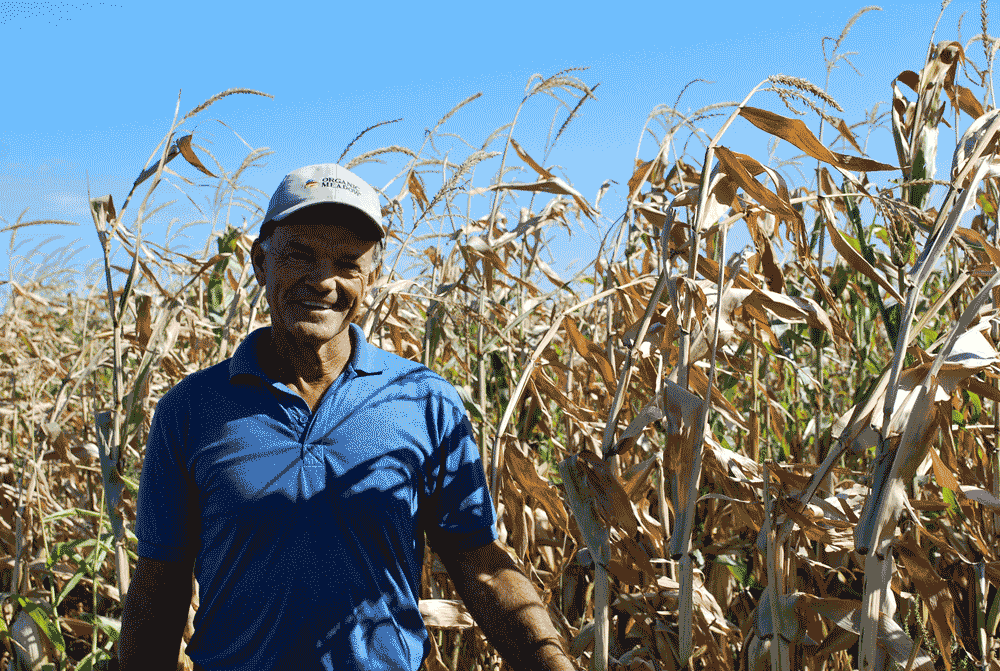An organic approach to growing corn
TAKING ADVANTAGE OF A SPECIALIZED NICHE MARKET
paul campbell says he’s never looked back since he switched from conventional to organic farming. Formerly a conventional farmer for twenty-five years, he now calls himself an organic corn farmer running 275 certified organic acres.
FIGURE 1. PAUL CAMPBELL SHOWS OFF HIS CROP NEAR FOREST, ONTARIO.

Located in Forest, Campbell began transitioning to organic one field at a time in 2000. Now, fully certified for the past four years he’s been enjoying the challenges, opportunities and benefits that come with his new approach to farming.
So what made Campbell switch his farming practices? He says he’s still thanking his neighbour today. When the opportunity arose to purchase his family farm from his brother, Campbell moved from a farm nearby and with the encouragement of a neighbour he turned a pasture field into organic soybeans. Impressed with the premiums from that first crop in 2000 he thought, I could learn to do this.
taking advantage of organics
With an average corn yield of 100 to 120 bushels per acre, higher premiums and reduced input costs it’s no wonder Campbell is still thanking his neighbour for suggesting he go organic. While he is content with his average yields, Campbell claims that organic farmers with access to livestock manure can achieve higher yields having no difficulty equalling conventional yields. While the yield potential continues to impress organic farmers the premiums for organic crops have declined slightly since Campbell’s first crop of soybeans. As with all agricultural commodities, prices and premiums are determined by supply and demand, but over the years Campbell has developed a rule of thumb, organic corn often brings him twice the price of corn on the conventional market. And while this isn’t always the case, Campbell is confident that his gross return per acre of corn is equal to or surpasses that of conventional farmers. Organic farming has significantly reduced his cost of production, another important number to his impressive gross return per acre. It’s no surprise that by eliminating chemical fertilizers and herbicides input costs are reduced considerably.
to market to market
A member of Organic Meadow Co-operative since 2002, Campbell utilizes the co-op’s grain merchandiser to sell most of his crops. And while that takes much of the burden off him that doesn’t mean he stops looking for new markets. Most of what he grows, including his corn, ends up in the organic feed grains market while some of his grains are sold within the co-op membership to organic dairy farmers. Campbell’s grains may also be exported through the co-op but he notes that the export market for organic feed grains is small and rather tough owing to limited organic livestock in the US, and most of those in the industry aren’t purchasing feed grains being self sufficient themselves.
His soybeans can be sold as organic food grade and the baking and flour industry are steady purchasers of wheat and spelt. Campbell’s crops frequently move closer to the end user after leaving his farm, often being delivered directly to a mill or dehuller. Marketing closer to the end user means marketing year round, a challenge for cash flow and storage. It was hard for Campbell to adjust to year round marketing when first transitioning to organics saying it was difficult to adjust from receiving a lump sum payment after harvest rather than small payments throughout the year. But, he also noted there are times he is able to realize better prices with year-round marketing.
the stats
Organic corn acres in Ontario totalled 10,000 in 2009. The crop, worth
$7 million was approximately 0.57 percent of the total corn acres in Ontario. Hugh Martin, Organic Crop Production Program Lead with the Ontario Ministry of Agriculture, Food and Rural Affairs says certified organic farms are growing at a rate of 10 percent per year. In 2008 grains and oilseeds production accounted for 50 percent of the overall organic acres, forages for 40 percent and fruits and vegetables for the remaining 10 percent.
weather and weeds, perennial problems
Campbell says that it doesn’t matter if you are farming conventionally or organic, every farmer has the same challenges. He’s quite sure he shares his two biggest challenges – weather and weeds – with most conventional farmers. “Timing is everything when it comes to farming, especially organic farming,” he says and without the use of herbicides Campbell must rely on other methods such as tine weeding, row cultivating and rotary hoeing to combat weeds. Campbell confers regularly with the weatherman because he says “I don’t have a jug on my shelf that allows me a 10 day window like my neighbours.”
feeling good about farming
It wasn’t an easy transition to organics. Campbell admits there were some bumps along the way, but he’s made a commitment to producing the best crops possible while being kind to his land and, in his opinion, the end consumer. And despite his ongoing challenges and interesting opportunities in organics his biggest problem right now is controlling sow thistle, a problem common amongst most farmers whether conventional or organic. •







